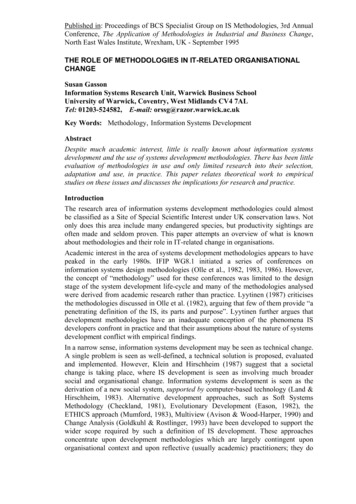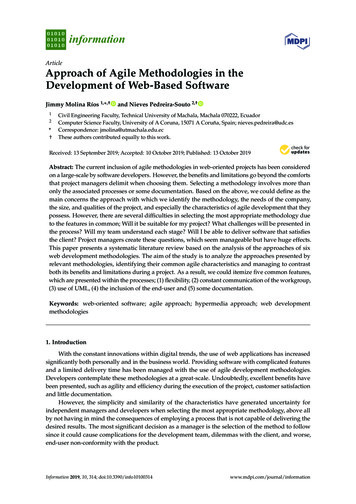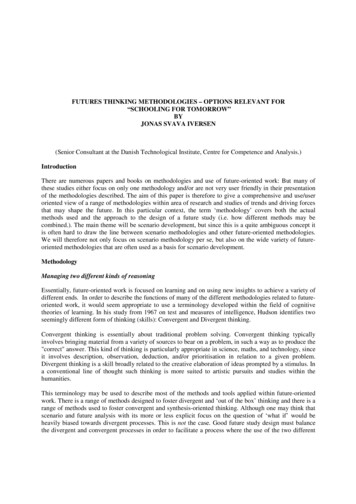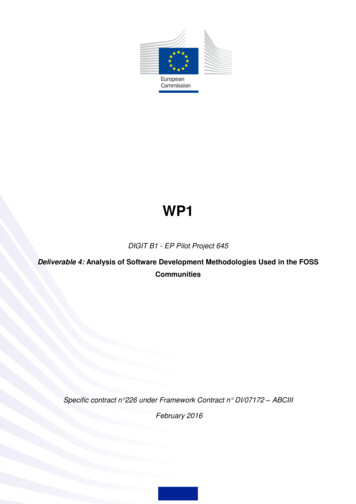
Transcription
Published in: Proceedings of BCS Specialist Group on IS Methodologies, 3rd AnnualConference, The Application of Methodologies in Industrial and Business Change,North East Wales Institute, Wrexham, UK - September 1995THE ROLE OF METHODOLOGIES IN IT-RELATED ORGANISATIONALCHANGESusan GassonInformation Systems Research Unit, Warwick Business SchoolUniversity of Warwick, Coventry, West Midlands CV4 7ALTel: 01203-524582, E-mail: orssg@razor.warwick.ac.ukKey Words: Methodology, Information Systems DevelopmentAbstractDespite much academic interest, little is really known about information systemsdevelopment and the use of systems development methodologies. There has been littleevaluation of methodologies in use and only limited research into their selection,adaptation and use, in practice. This paper relates theoretical work to empiricalstudies on these issues and discusses the implications for research and practice.IntroductionThe research area of information systems development methodologies could almostbe classified as a Site of Special Scientific Interest under UK conservation laws. Notonly does this area include many endangered species, but productivity sightings areoften made and seldom proven. This paper attempts an overview of what is knownabout methodologies and their role in IT-related change in organisations.Academic interest in the area of systems development methodologies appears to havepeaked in the early 1980s. IFIP WG8.1 initiated a series of conferences oninformation systems design methodologies (Olle et al., 1982, 1983, 1986). However,the concept of “methodology” used for these conferences was limited to the designstage of the system development life-cycle and many of the methodologies analysedwere derived from academic research rather than practice. Lyytinen (1987) criticisesthe methodologies discussed in Olle et al. (1982), arguing that few of them provide “apenetrating definition of the IS, its parts and purpose”. Lyytinen further argues thatdevelopment methodologies have an inadequate conception of the phenomena ISdevelopers confront in practice and that their assumptions about the nature of systemsdevelopment conflict with empirical findings.In a narrow sense, information systems development may be seen as technical change.A single problem is seen as well-defined, a technical solution is proposed, evaluatedand implemented. However, Klein and Hirschheim (1987) suggest that a societalchange is taking place, where IS development is seen as involving much broadersocial and organisational change. Information systems development is seen as thederivation of a new social system, supported by computer-based technology (Land &Hirschheim, 1983). Alternative development approaches, such as Soft SystemsMethodology (Checkland, 1981), Evolutionary Development (Eason, 1982), theETHICS approach (Mumford, 1983), Multiview (Avison & Wood-Harper, 1990) andChange Analysis (Goldkuhl & Rostlinger, 1993) have been developed to support thewider scope required by such a definition of IS development. These approachesconcentrate upon development methodologies which are largely contingent uponorganisational context and upon reflective (usually academic) practitioners; they do
not provide alternative models for the processes engaged in by IS professionals withlimited time and resources.To understand the options open to us, when proposing changes in practice, we need tounderstand what that practice is: to investigate the role played by methodologies inIT-related change. This paper presents an investigation into that role by examiningrecent empirical evidence to answer three questions:1. What methodologies are in use?2. How are systems development methodologies selected?3. To what extent do methodologies support systems development?Before addressing these questions, it is useful to examine what is meant by the term‘information systems development methodology’.What Is An Information Systems Development Methodology?There has been some debate about whether the term ‘methodology’, which literallymeans “the study of methods” can be used to refer to a particular methodologicalapproach to information systems development. Jayaratna (1994) emphasises that amethodology provides an “explicit way of structuring” systems development:“Methodologies contain models and reflect particular perspectives of ‘reality’ based on a setof philosophical paradigms. A methodology should tell you ‘what’ steps to take and ‘how’to perform those steps but most importantly the reasons ‘why’ those steps should be taken,in that particular order.” Jayaratna (1994), pg. 37.Maddison et al. (1984) define a methodology as “a recommended collection ofphilosophies, phases, procedures, rules, techniques, tools, documentation,management and training for developers of information systems”, while Avison &Fitzgerald (1988) state that:“A methodology is a collection of procedures, techniques, tools and documentation aidswhich will help the systems developers in their efforts to implement a new informationsystem. A methodology will consist of phases, themselves consisting of sub-phases, whichwill guide the system developers in their choice of the techniques that might be appropriateat each stage of the project and also help them plan, manage, control and evaluateinformation systems projects”. Avison & Fitzgerald (1988), pg. 4.In the sense given in each of these definitions, a methodology is more than just amethod (the ‘how’ of information systems development), or a process-model. Amethodology is an holistic approach: it embodies an analytical framework which isconveyed through intersubjective representational practices and operationalisedthrough a ‘toolbox’ of analytical methods, tools and techniques. Underlying theanalytical framework is a process-model which indicates the sequence and relativeduration of development activities. Standardised organisational procedures, such asuser-participation mechanisms or formal review meetings, are critical to an holisticdefinition of a methodology, so that development outputs may conform to pre-definedstandards, may be governed by pre-defined expectations and so that there may be aunified system of control over all IS development projects which use themethodology. Underlying all of these elements is a philosophical basis, whichjustifies the need for each element of the methodology and ensures intersubjectivityand commitment between development team members.The elements of a methodology are illustrated in Figure 1. These elements permit anindividual to structure their understanding of appropriate solutions for a problemsituation, according to their perspective and their previous experience of both theproblem context and the methodology. A methodology affects the way in which
individuals’ will perceive the context and tasks of development, with each componentlayer of the methodology acting as a filter to the next layer. Ultimately, the problemsituation is perceived through the filters provided by successive elements of themethodology; these elements in turn are filtered through stakeholders’ perceptions oftheir utility and application. Thus stakeholders’ perceptions of the representationaltechniques which they use will be coloured by the organisational procedures andstandards which provide the context for their use. For example, a client may perceivea problem-situation as very complex when viewed through the filters of a “hard”systems philosophy, rigid waterfall process-model, data-analysis, entity-relationshipdiagrams and formal user-validation meetings, but might view the same problemsituation as much less complex when viewed through the filters of a user-centredphilosophy, evolutionary development, activity-modelling, SSM conceptual modelsand full user-participation in development.DeveloperPerspective &ExperienceMETHODOLOGYManager Perspective & ExperienceClientPerspective &ExperienceProcedures and standardsRepresentational techniquesAnalytical frameworkProcess ModelPhilosophyThe problem situationFigure 1: The Elements of a MethodologyDifferent people may have very different understandings of a methodology,depending upon their background and their experience of this type of methodology. Inthe context of this scope of meaning, the use of the term methodology in the widesense used by development practitioners does not seem inappropriate, especially inthe context of a body of academic research which has as its objective theimprovement of information systems development practice; to use the term “method”does.Methodologies may differ widely in terms of their philosophy, objectives and systemmodelling approaches. Avison (1990) classifies methodologies as pertaining to sevendifferent approaches: systems approaches, planning approaches, participativeapproaches, prototyping approaches, automated approaches, structured approachesand data approaches. Avison’s classification and descriptions have been used togenerate Table 1, which illustrates differences between various types ofmethodologies. The classification cannot be said to be exhaustive. Missing, forexample, is the traditional approach, classified by Boehm et al. (1984) as the“specifying” approach: as requirements are specified (it is assumed, completely)before the design phase begins. The traditional approach uses the waterfall model tomanage the process but its support of design processes is unstructured and does notuse the decompositional tools and techniques of structured methodologies.
There is confusion in many studies about the definition of various methodologies:while Avison (1990) sees structured approaches as distinct from the data approach(centred upon data structures and the use of ‘data dictionaries’), Sumner & Sitek(1986) note that structured systems analysis combines process design and data design,using such tools as a data dictionary. Traditional methodologies are often confusedand/or combined with structured methodologies, because they use the same processmodel. In the context of this paper, the term ‘structured methodology’ is used to meanany methodological approach which is based upon structured decomposition ofsystem requirements and managed using the waterfall model of the systemdevelopment life-cycle. The traditional approach is not seen as using a developmentmethodology in the wide sense discussed above, but as an approach to projectmanagement and control.ApproachPerspective/PhilosophySoft systemsapproachOrganisational problems areill-defined. Philosophy is tounderstand the organisationholistically, analysing thestructure of organisationsfrom many perspectives.IS development should bealigned with strategicbusiness needs.Effective IS development isbased on emancipatoryorganisational proachesDataapproachesVaries: prototyping may beused for emancipatory orexperimental, technicalpurposes. May be one-off orevolutionary.Problems in IS developmentlie in imprecise definition oftechnical system and lack ofaccurate documentation.A well-definedorganisational ‘problem’forms the basis for the newsystem. There is ‘one bestway’ of approachingdevelopmentThe organisation can beunderstood through ananalysis of its use ofinformation.The approachaddresses:Organisational‘problem’ definition.Information systemobjectives andrequirements analysis.The approachneglects:Later stages of thesystems developmentlife-cycle (SDLC).Pre-planning involvedin developinginformation systems.User appreciation anddetermination of systemoperation andlimitations.User and/or developerappreciation oftechnical systemoperation andlimitations.Early definition ofsystem requirements.Rapid production ofsystem design &implementation fromspecified requirements.Early definition ofsystem requirements.Standardisation & coordination ofdevelopment tasks.Actual operationalneeds of thedevelopment project.Wider organisationalimplications, such asstructural changes.Use of technology tosupport existing orrequired data-flows andtransactions.Human, social andorganisational impactsof system.Concentrates on localsystem, neglectingwider organisationalimplications, such asstructural changes.Human, social andorganisational impactsof system.Human, social andorganisational impactsof system.Table 1: Classification of Information Systems Development Methodologies WithRespect to Development Process (derived from Avison, 1990)Saarinen (1990) classifies methodologies by four variables:(i) the system development strategy: linear (waterfall model), mixed methodology,or prototyping (by which he means evolutionary development)(ii) software development tools: software package, third-generation programminglanguage or application generator (4GL)(iii) the formality of the system development method(iv) the level of planning and management control in the project.
Saarinen’s (1990) classification is useful for detailed analysis of developmentapproaches, but concentrates as much on the management of the methodology as onthe type of methodology. Whilst this is essential for an understanding of howmethodologies are used, a more useful perspective for what approaches are in usemight be to classify methodologies by their main objective. This has been attemptedin Table 2, which concentrates upon development strategies, rather than the tools andmethods which are used to support individual entThe main problem of ISdevelopment is lack ofcontrol over the process.Understanding of systemrequirements at start ofproject is imperfect andneeds to be redefined asobjectives become apparent.Existing organisationalstructures impede businesseffectiveness. "Throw it allaway & start again".Efficiency is best maintainedthrough not reinventing thewheel each time a newsystem is developed.A technical solution can beoptimised by use of formalnotations to precisely definesystem operations.Emancipatory: social, taskand organisational aspects ofthe information system needto be optimised jointly withtechnical aspects.Rapid-cycle iteration indevelopment can effectivelyincorporate feedback fromusers on system impact onorganisation and work tasks.An information system maybe defined through its datastructures. Given suitabletools, production of technicalsystems can be eeringThe approachaddresses:Standardisation & coordination ofdevelopment tasks.Evaluation of fitbetween current taskoutcomes and latestunderstanding ofsystem requirements.The design of all levelsof business activitiesand process, fromstrategic to operational.Production of softwarelibraries, from whichsystem componentsselectedSystems where theproblem is welldefined and a technicalsolution is appropriate.Design of work andsocial system andspecification oftechnical supportsystem requirements.Organisational fit ofsystem and adaptationto change. Relies onthe use of RAD, 4GL,or prototyping tools.Precise analysis anddesign of data modelsto support organisationinformation flows.The approach neglects:Human, social andorganisational impactsof system.Financial/resource focus- neglects human, socialand organisationalimpacts of system.The detaileddevelopment ofphysical systems.Human, social andorganisational impactsof system.Human, social andorganisational impactsof system.Appropriate design andevaluation of technicalsystem. Relies onpractitioner expertise asmuch as methodology.Financial andmanagement control ofprocesses. May be usedexperimentally or foremancipation.Human, social andorganisational impactsof system.Table 2: Classification of Methodologies By Development StrategyA classification of methodologies does not tell us much about organisational practice:only about what academics and consultants, the originators of most methodologies,think is desirable for organisational practice. Jeffries et al. (1981) argue that theprofessional literature in the field of software design (by which they meanmethodology guidelines) ought to relate to accepted standards of good practice as theformalised methodologies were written by experts trying to convey to others theprocedures they used to perform the task. However, empirical research inorganisational contexts (c.f. Jenkins et al., 1984; Curtis et al., 1988; Hornby et al.,1992; Davidson, 1993) shows that methodologies do not represent a ‘theory-in-use’,but a ‘theory-of-action’ (Argyris and Schon, 1978): they represent a rule-basedinterpretation of what should be done, rather than what people actually do.
What Methodologies Are In Use?Empirical studies of methodology diffusion are rare - the practical problems ofstudying the use of methodologies in organisations mean that few researchersundertake this type of study. In the US, Wynekoop & Russo (1993) report a surveywhich indicates that structured methodologies (based upon the detailed specificationand structured decomposition of documented system requirements) were in use inabout two-thirds of their sample organisations. However, Jenkins et al. (1984)indicate that 43% of users of a commercial systems development methodology and50% of users of methodologies developed in-house felt that their methodology wasprimarily a project management aid - controlling the process through staged divisionof tasks - rather than an aid to system development. This emphasis reflects atraditional, rather than a structured approach. This finding may have occurred becausethe study was conducted at a time when the “software crisis” was perceived to bemainly about managing the development process (Friedman and Cornford, 1989).Once process management was perceived to be under control, the crisis moved on, tobecome a concern with user-relations, which may explain the preoccupation withprototyping and user-participation approaches which is found in more recentliterature.In the UK, Hornby et al. (1992) found that most organisations used traditional orstructured methodologies (the study did not distinguish between the two) for systemsdevelopment. Hopker (1994), in a survey of 89 Welsh organisations found thatstructured methodologies were used by only 33%, less than the 43% usingprototyping approaches (however, traditional, waterfall-model approaches were usedby 75% of her sample and many of these may have been using structureddecomposition approaches, if not the complete, formal methodology).Saarinen (1990) used the classification framework discussed in the previous section ina study of 21 large, Finnish companies. Two-thirds of Saarinen’s sample used linearstrategies for system development, indicating traditional or structured approaches.58% of the sample used third-generation languages to produce the software, with 21%using application generators and 21% using software packages. The average rating ona seven-point scale for formality of the method and management control were 3.98and 4.46 respectively. This gives a picture very like the US and the UK: showing anoverriding concern for process standardisation and hence control (the main benefit ofstructured and traditional methodologies) rather than support for the creative,communication and learning processes of system stakeholders and softwaredevelopers.In both the UK and the US, the majority of those sites which do not use traditional orstructured development methodologies use a totally unstructured developmentprocess, with no overall methodology (Boehm, 1988; Avison & Fitzgerald, 1988).Boehm (1988) refers to these approaches as “code and fix”. Compared with thisalternative, structured methodologies, even with their lack of human-centredness,look attractive!A survey of senior IT managers in 49 large UK organisations was performed in 1995(Gasson & Holland, 1995)1. Of those 32 respondents who performed their software1The study of development approaches was performed as part of a larger survey, by TransitionPartnerships, of senior IT, functional and finance managers. Copies of the full report can be purchased
development in-house (and were therefore able to report on development approaches),it was found that only a small minority of sites used ‘alternative’ systemsdevelopment methodologies, such as evolutionary prototyping, or approaches tosupport user-participation. The survey findings are represented graphically in Figure2.65% of the sample used the same methodological approach for all three stages of theSDLC. 85% of the sample used an approach in the same group (using theclassification of figure 2) for all three stages. The majority of the reported approacheswere primarily concerned with standardising the process (structured methodologies,computer-aided software engineering (CASE) and internal change control). The nonuse of any formal methodological approach was fairly high, but the category “none”may be over-reported as it is possible that the senior IT manager did not know whatmethods were used in detail. In later stages of the SDLC, there appears to be a slightswitch to that group of approaches concerned with speed or automation ofsystem/program generation - fast-build tools, such as the use of 4GLs in RapidApplication Development, CASE or DataBase Management Systems. Theseapproaches might be selected because more organisations are building systemprototypes (perhaps for experimental purposes) or it might be that projectsincreasingly suffer from time-scale pressures as development proceeds.100%80%Prototyping,user-participationRAD, CASE,DBMS (Fast build tools)60%40%Structured tationFigure 2: Primary Methodology Used For System DevelopmentThese findings show a high use of automation and fast-build approaches. A largeproportion of those papers and journal articles aimed at practitioners discuss meritsand problems with the CASE approach and, as shown by the survey above, CASEbased methodologies have a significant share of the market. However, considerationof the diffusion of fast-build approaches is largely missing from academic literature.This is possibly because of the preoccupation with prototyping and users discussedearlier, which leads to methodologies being classified into user-participatory or nonuser participatory (a classification which sidelines automation of the process).The overall picture, then, is that the methodologies in use, regardless of nationalculture, pertain mainly to process standardisation (and hence control) and resourcemanagement, rather than the support of team communications, learning, userinvolvement or product quality assessment. There appears to be a significant interestin automating software production processes through CASE, but its impact is difficultto gauge as most studies of systems development investigate aspects of the systemsfrom Transition Partnerships, Hernshaw, Knowle Lane, Cranleigh, Surrey GU6 8JH, Tel: 01483278452
development process which are not automated, such as user-requirements elicitation.Although the “software crisis” may be deemed to be over by academics, theincreasing use of automated tools may indicate that it looms large in managementconsciousness.How Are Methodologies Selected?Kumar and Bjorn-Andersen (1990) state that the prescription of a particularmethodology incorporates into the design process “the ontological assumptions aboutwhat constitutes reality and the epistemological assumptions about how to conductthe ISD enquiry.” This methodological determinism is challenged by Markus &Bjorn-Andersen (1987) who argue that designers’ existing value systems influencethe selection of development methodologies: IS development approaches are largelybased upon a waterfall model and emphasise technical/functional optimisationbecause technical expertise is the basis of IS professionals’ power.If designers’ value-systems are formed by the use of a particular methodology, onewould expect a very wide variety of IS development cultures in practice, dependingupon the methodology in use. This was not found to be so in the studies whichexamine this aspect. Hornby et al. (1992) found that information systemsdevelopment is viewed primarily within organisations as a technical problem andtherefore approached using technical, function-oriented approaches. This finding issupported by Gasson & Holland (1995). It must be said that there is an element of‘chicken-and-egg’ about this debate: do these findings reflect the impact oftechnically-oriented methodologies upon designers’ value-systems, or do they reflectthe impact of designers’ value systems upon the selection of methodologies?There is no clear consensus on why certain methodologies may be selected for use.Saarinen’s (1990) study started from the position that a particular methodology mightbe selected according to contingency factors: the clarity of the system ‘problem’, thelevel of complexity, the level of uncertainty, the size of the project, the familiarity ofthe technology etc. However, no discernible link was found between any of thecontingency factors and the type of methodology selected: Saarinen concludes thatextraneous factors or company standards may have had more influence on the choiceof methodology than a rational consideration of alternatives based upon therequirements of the project. Hopker (1994) also argued that it would be rational to usea contingency approach to methodology selection, based upon a strategicclassification of the target application. She found little evidence that this approachwas used by organisations in practice; selection of methodologies was dominated byhistorical influences, with a “pick and mix” approach prevailing.Rosenbrock (1981) suggests that engineers and designers learn a normative approachto problem-solving through the group processes of education and negotiationprovided by the project design team, which engenders a positivist and anti-humanistapproach to the design of technology. Research on design processes suggests thatdesigners construct a ‘design schema’: a mental construct which encompasses anunderstanding of the processes of design and of acceptable solutions for certain typesof problems. This schema is derived from the designer’s background, education andprevious experience of the application domain (c.f. Jeffries et al., 1981; Guindon etal., 1987). If schemas are formed through the normative influences of working inproject teams, then it is unsurprising that the selection of development methodologies
is based primarily on historical influences: developer experience and methodologyreinforce each other in a vicious (or virtuous) circle.Many developers under-report their use of methodologies: developers are oftenunaware of the provenance of many of the techniques which they use and are resistantto change (Neccho, 1989). There appears to be a widespread lack of awareness ofalternative development approaches and developers acquire their knowledge aboutavailable methodologies through informal means, such as periodicals, seminars andvendor training; formal training plans and budgets are non-existent (Neccho, 1989).If developer training is largely achieved through normative learning, this means thatmany of the approaches used by a developer will necessarily be an amalgam of thevarious approaches used by teams with which they have worked previously, ratherthan a rationally-selected methodology, used in its intended philosophical context.Empirical studies by Curtis et al. (Curtis et al., 1988; Curtis & Walz, 1990; Curtis,1992) indicate the importance of the ‘expert designer’: an experienced team memberwho spends most of his or her time educating more junior team members in issuesrelevant to the application domain and the processes of development. The expertdesigner can often have a great deal of influence over the analytical techniques in useby a particular team, sometimes more influence than senior IS managers.Contingency approaches may not be relevant in the selection of CASE tools.Orlikowski (1993) found that IS developers believed that CASE tools helped them toappear more productive and hence more valuable to their employer. IS managersvalued CASE because it allowed them to perform system integration across theorganisation with fewer resources and faster than they could otherwise have done, butthere was resistance from business managers, who saw CASE as a mechanism forexpanding the power of the IT department. Because CASE provided a rapid (andlargely implicit) justification to change both corporate data structures and ownershipand systems development processes, it provided an effective mechanism to implementIS managers’ intentions, whether these were to take control by introducing radicalchange or to share control by supporting incremental organisational or productchange.The type of methodology selected is not the only factor in determining howdevelopment proceeds in an organisation. Many completely different methodologicalapproaches may yield similar cultures, benefits or problems in practice. For example,users may be permitted to participate to a high degree in system development projectswhich use structured methodologies (Hardy et al., 1994) and may be excluded fromsystem development which uses evolutionary prototyping approaches (Gasson, 1995).Whilst participatory approaches concentrate upon user appreciation and determinationof the operation and limitations of new systems, prototyping approaches whichconcentrate upon developer appreciation and determination of the operation andlimitations of new systems may lead to unintended user emancipation, through userevaluation of prototypes. Different methodological approaches may share many of thesame objectives and may use common tools and methods. A classification of themethodology is therefore insufficient in determining its effect upon the developmentprocess: it is necessary to look at the approach in a much wider sense.
To What Extent Do Methodologies Support Sy
about methodologies and their role in IT-related change in organisations. Academic interest in the area of systems development methodologies appears to have peaked in the early 1980s. IFIP WG8.1 initiated a series of conferences on information systems design methodologies (Olle et al., 1982, 1983, 1986). However,










